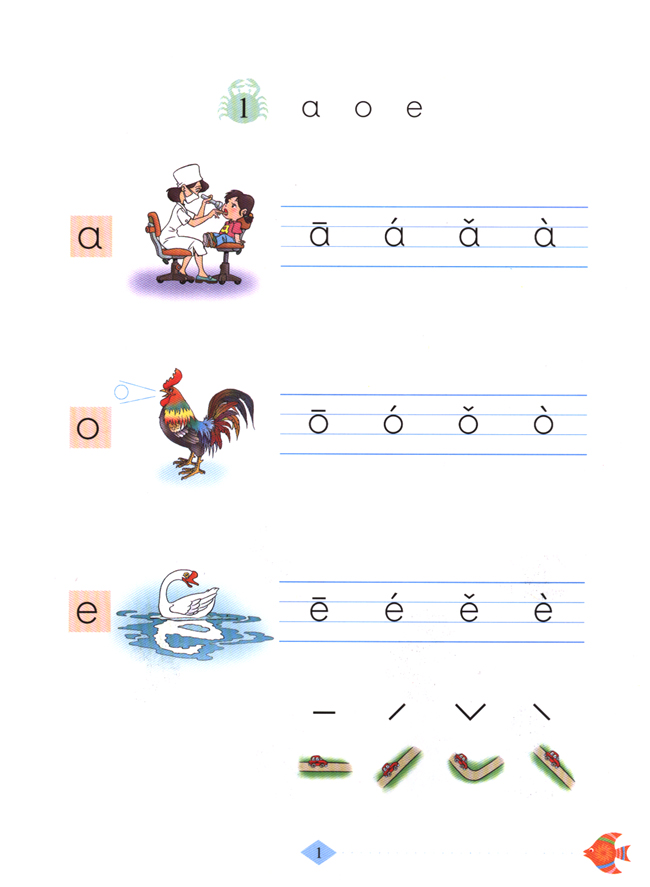1.┬Ā µŗ╝ķ¤│┬Ā┬Āp─½n y─½n (notations representing Chinese-language Joint Sounds)
| (1)ÕŻ░µ»Ź sh─ōng mŪö (initial consonants)┬Ā 21+2=23 | ||||
| b | p | m | f | |
| d | t | n | l | |
| g | k | h | ┬ | |
| j | q | x | ┬ | |
| zh | ch | sh | r | |
| z | c | s | ┬ | |
| y | w | (many books do not include the last twos into initials) | ┬ | |
| How Chinese┬Āpupils are taught at school with regard to Pinyin: Recite group by group (such as “b, p, m, f” as a group)Resort to specific Chinese character for each Pinyin (such as: to remember “j”, we resort to “ķĖĪ j─½-chicken” or whatever you feel easy to learn by heart). | ||||
| ┬ | ||||
| (2)ķ¤Ąµ»Ź y├╣n mŪö (finals ) 24 | ||||
| a | o | e | ┬ | |
| i | u | ├╝ | The former six are vowels, also called simple finals | |
| ai | ei | ui | ┬ | |
| ao | ou | iu | ┬ | |
| ie | ├╝e | er | These nine are compound finals; and below are nasal finals | |
| an | en | in | un | ├╝n |
| ang | eng | ing | ong | |
| ┬ | ||||
| Another form for Finals┬Ā (no need to recite this form, but pay attention to those marked in┬Āpurple and know that sometimes there are two finals in one character, and also pay attention to the remarks) 24 +12 | ||||
| ┬ | i | u | ├╝ | |
| a | ia | ua | ┬ | |
| o | ┬ | uo | ┬ | |
| e | ie | ┬ | ├╝e | |
| ai | ┬ | uai | ┬ | |
| ei | ┬ | uei-ui | ┬ | |
| ao | iao | ┬ | ┬ | |
| ou | iou-iu | ┬ | ┬ | |
| an | ian | uan | ├╝an | |
| en | in | uen-un | ├╝n | |
| ang | iang | uang | ┬ | |
| eng | ing | ueng | ┬ | |
| ong | iong | ┬ | Special: er | |
Remarks:
|
||||
For the audio material for every Pinyin, please refer to┬Ā┬Āķćæń¤│µ▒ēĶ»Ł
2. ÕŻ░Ķ░ā┬Āsh─ōng mŪö (Tones)
| Script of tones | Name of tones | Description | Concept& example | Vocal cord |
─ü |
1st | High and level | Like sing out an English syllable, eg. ĶĪŻ(y─½), sing out [i:] | Keep tightest, almost no change (the sound is long) |
├Ī┬ |
2nd | Rising (middle low to high) | Like Doubt: Did you say ńÄŗ(w├Īng)? | Not tight not loose, stretch till the tightest (long) |
ŪÄ┬ |
3rd | Low (with rise):If read separately, fall then rise;If in the context with other characters, aiming at low (except in two consecutive third tones) | Aiming at low when read together with other characters in contextsEg: ÕŠłķ½śh─øn g─üo,õ╣”µ│Ģ sh┼½ fŪÄ | A little bit tight–loosen & extend,suddenly tighten, but not to the tightest(if read separately, the longest, but in the context with other characters,short) |
├ |
4th | Falling (very high then low) | Like LIST final intonation or Certainty. Eg: “I said Wei4” or “It is late!” or “1, 2, 3 (all rising) and 4(falling)!” | Tight–loosen till completely loose(short) |
a |
Light tone | Toneless, depending on contexts | ┬ | ┬ |
*The tone form above is┬Āderived from MIT Open course (see resources)
Note: the third tone: If an expression is made up of two third tones, the first one shall be read as the second tone. Eg. ÕŠłÕźĮh─øn hŪÄo, both are the third tone, so the first character ÕŠłshall be read as the second tone, but the written form is still the third tone.
Learn to tune into the right tones:
“µ▒ĮĶĮ”Õ╣│ĶĄ░─ü ─ü ─ü’╝īµ▒ĮĶĮ”õĖŖÕØĪ├Ī ├Ī ├Ī’╝īµ▒ĮĶĮ”õĖŗÕØĪÕÅłõĖŖÕØĪŪÄ ŪÄ ŪÄ’╝īµ▒ĮĶĮ”õĖŗÕØĪ├Ā ├Ā ├Ā”—- “The car┬Āruns on flat road┬Ā─ü ─ü ─ü, the car runs uphill ├Ī ├Ī ├Ī, the car┬Āruns uphill and downhill ŪÄ ŪÄ ŪÄ, the car runs downhill ├Ā ├Ā ├Ā!” (Picture source: www.pep.com.cn People’s Education Press)

3. µ▒ēÕŁŚń¼öńö╗h├Ān z├¼ bŪÉ hu├Ā’╝łCharacter Strokes)
Basic Strokes
ńé╣ diŪÄn ’ĮĆ┬Ā┬Ā (Õ░Å┬Ā┬Ā ÕģŁ) Dot,from top to bottom-right
µ©¬ h├®ng┬ĀõĖĆ┬Ā (õĖĆ┬Ā┬Ā Õż¦) Horizontal stroke,from left to right
ń½¢ sh├╣ õĖ©┬Ā┬Ā ┬Ā(ÕŹü┬Ā┬Ā┬Ā Õ╣▓’╝ēVertical stroke,from top to bottom
µÆć pi─ø ŃāÄ┬Ā┬Ā┬Ā┬Ā (õ║║┬Ā┬Ā┬Ā Õģ½) Downward-left stroke,from top to bottom-left
µŹ║ n├Ā┬Ā õ╣Ć┬Ā┬Ā┬Ā┬Ā (õ║║┬Ā┬Ā┬Ā Õģ½)Downward-right stroke,from top to bottom-right
µÅÉ t├Ł┬Ā┬Ā┬Ā┬Ā┬Ā┬Ā┬Ā┬Ā┬Ā┬Ā┬Ā (µłæ┬Ā┬Ā µēō) Upward,from bottom-left to top rigth
Stroke Order
Horizontal then vertical.(õĖŗ, ÕŹü )┬Ā┬Ā┬Ā┬Ā┬Ā Falling leftwards then falling rightwards (õ║║, Õż®)
From top to bottom (õĖē, ĶČ│)┬Ā┬Ā┬Ā┬Ā┬Ā┬Ā┬Ā┬Ā┬Ā┬Ā┬Ā┬Ā From left to right (ń║ó, õĮĀ)
Outside then inside (µ£ł, Ķéē)┬Ā┬Ā┬Ā┬Ā┬Ā┬Ā┬Ā┬Ā┬Ā┬Ā┬Ā┬Ā┬Ā Sometimes inside then outside(Õ▒▒, Ķ┐Ö)
Middle then two sides┬Ā (Õ░Å, µ░┤)┬Ā┬Ā┬Ā┬Ā┬Ā┬Ā┬Ā┬Ā┬Ā From outside to inside then close it up(µŚź, Õøø)
┬
┬